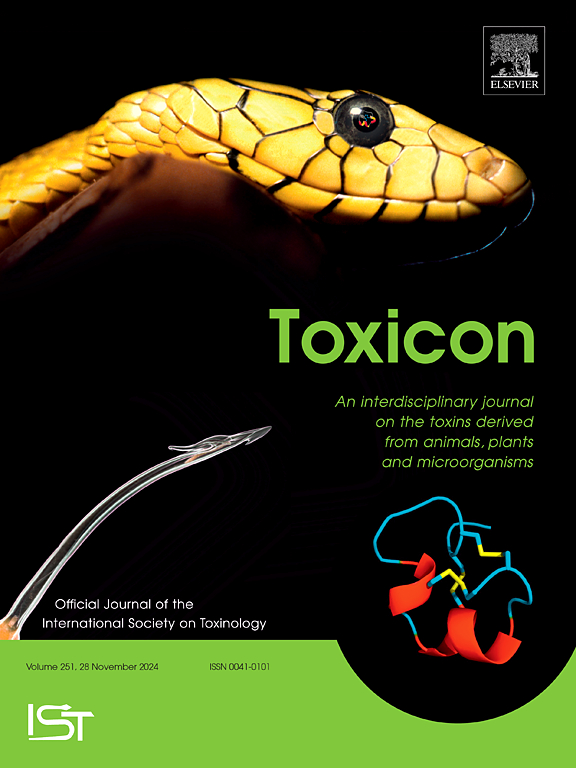Self-reported health effects after one year from a viper bite: A prospective study from France
IF 2.6
4区 医学
Q2 PHARMACOLOGY & PHARMACY
引用次数: 0
Abstract
In France, the summer period (from mid-April to mid-September) is particularly prone to viper envenomations by the two most common species, Vipera aspis and Vipera berus, which represents a significant public health issue. Although mortality is extremely low and systemic signs are rare, some patients experience long-term functional sequelae, highlighting the need for further exploration of the prolonged effects of snakebites.
We conducted an observational study of viper bite cases in France collected during routine follow-ups by four Poison Control Centers. Patients were followed up by toxicologists using a standardized survey to assess recovery time and health indicators.
Over two years, 170 patients were included, with a sex ratio of 1.54 (103 males vs. 67 females) and a median age of 46.2 years. The median recovery time was 21 days, with 84 % of patients healed by 6 months, and recovery probabilities of 0.47, 0.65, and 0.86 at 14, 30, and 180 days, respectively. Parameters associated with delayed recovery were severe bite, lower limb bite, female gender, inappropriate treatment, and time to hospital admission. Age and time to administration of antivenom had no effect. One month after the bite, 12.8 % of patients avoided the activity during which they were bitten, 5.6 % frequently thought about the bite, and 22.3 % were afraid of snakes; these figures increased to 14.6 %, 4.5 %, and 38.2 %, respectively, after one year.
Other factors than severity of envenomation should be taken into account in the long-term prognostic assessment of patients. Psychological impacts, though not clinically classified as traumatic events, suggest a need to consider mental health in recovery.
Prompt administration of antivenom and compliance with recommended management remain key elements of effective care. It is important to re-evaluate the need for patient follow-up in the light of the factors identified as affecting the early favourable evolution of symptoms.

毒蛇咬伤一年后自我报告的健康影响:一项来自法国的前瞻性研究
在法国,夏季(从4月中旬到9月中旬)特别容易受到两种最常见的毒蛇的毒害,即阿斯蝰蛇和贝鲁斯蝰蛇,这是一个重大的公共卫生问题。虽然死亡率极低,全身症状罕见,但一些患者会出现长期的功能性后遗症,这表明需要进一步探索蛇咬伤的长期影响。我们对法国四个中毒控制中心在常规随访中收集的毒蛇咬伤病例进行了观察性研究。毒理学家采用标准化调查对患者进行随访,以评估恢复时间和健康指标。两年内纳入170例患者,性别比为1.54(男性103例,女性67例),中位年龄46.2岁。中位康复时间为21天,6个月治愈率为84%,14天、30天和180天的康复率分别为0.47、0.65和0.86。与延迟恢复相关的参数是严重咬伤、下肢咬伤、女性、不适当的治疗和入院时间。年龄和服用抗蛇毒血清的时间没有影响。被咬后1个月,12.8%的患者避免被咬时的活动,5.6%的患者经常想到被咬,22.3%的患者害怕蛇;一年后,这一数字分别增加到14.6%、4.5%和38.2%。在对患者进行长期预后评估时,除中毒严重程度外,还应考虑其他因素。心理影响虽然在临床上未被归类为创伤性事件,但表明在康复过程中需要考虑心理健康。及时给予抗蛇毒血清并遵守建议的管理仍然是有效护理的关键要素。重要的是,根据确定的影响早期有利症状演变的因素,重新评估患者随访的必要性。
本文章由计算机程序翻译,如有差异,请以英文原文为准。
求助全文
约1分钟内获得全文
求助全文
来源期刊

Toxicon
医学-毒理学
CiteScore
4.80
自引率
10.70%
发文量
358
审稿时长
68 days
期刊介绍:
Toxicon has an open access mirror Toxicon: X, sharing the same aims and scope, editorial team, submission system and rigorous peer review. An introductory offer Toxicon: X - full waiver of the Open Access fee.
Toxicon''s "aims and scope" are to publish:
-articles containing the results of original research on problems related to toxins derived from animals, plants and microorganisms
-papers on novel findings related to the chemical, pharmacological, toxicological, and immunological properties of natural toxins
-molecular biological studies of toxins and other genes from poisonous and venomous organisms that advance understanding of the role or function of toxins
-clinical observations on poisoning and envenoming where a new therapeutic principle has been proposed or a decidedly superior clinical result has been obtained.
-material on the use of toxins as tools in studying biological processes and material on subjects related to venom and antivenom problems.
-articles on the translational application of toxins, for example as drugs and insecticides
-epidemiological studies on envenoming or poisoning, so long as they highlight a previously unrecognised medical problem or provide insight into the prevention or medical treatment of envenoming or poisoning. Retrospective surveys of hospital records, especially those lacking species identification, will not be considered for publication. Properly designed prospective community-based surveys are strongly encouraged.
-articles describing well-known activities of venoms, such as antibacterial, anticancer, and analgesic activities of arachnid venoms, without any attempt to define the mechanism of action or purify the active component, will not be considered for publication in Toxicon.
-review articles on problems related to toxinology.
To encourage the exchange of ideas, sections of the journal may be devoted to Short Communications, Letters to the Editor and activities of the affiliated societies.
 求助内容:
求助内容: 应助结果提醒方式:
应助结果提醒方式:


